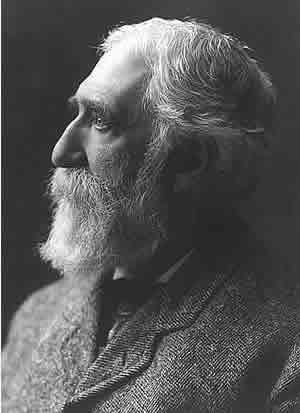Refining the Work and Scattering the Manuscript
The new uniform edition of The Gilded Age offered both
Clemens and Warner an opportunity to revise and refine their work. However,
there is little evidence to suggest either man took an active interest in
doing so. Frank Bliss, however, did offer translations to Trumbull's mysterious
foreign-language chapter heading mottoes in appendixes at the back of Volumes
10 and 11. The 1899 uniform edition represents the first appearance of Trumbull's
translations into English.
In what became a disappointing practice to today's scholars,
Frank Bliss also bound individual manuscript pages from The Gilded Age
written by both Clemens and Warner into the first volumes of the Autograph
Edition as an enticement to book buyers. This practice effectively scattered
the manuscript for The Gilded Age worldwide making it difficult,
if not impossible, to ever reconstruct the exact composition of the novel
itself.
Production of the new 1899 plates also had the potential to introduce inconsistencies
into the texts that were the result of typesetting errors.
|
Frank Bliss intended to correct any errors for subsequent printings
and hired Forrest Morgan (b. 1852 - d. 1924), a fastidious proofreader,
to weed out errors. Morgan, a former editor of the Hartford Travelers
Record and later an assistant librarian at Watkinson Library in
Hartford, read from a set of the Royal
Edition to mark errors.
Clemens was familiar with the work of Forrest Morgan in Travelers
Record. When Clemens wrote "Stirring Times in Austria"
in 1897 he quoted from a long passage he credited to Morgan to describe
the history of disunity in the Austro-Hungarian empire. "Stirring
Times in Austria" was published in Harper's Monthly in
March 1898 and is reprinted in Volume 22.
Morgan's 22-volume set of the Royal Edition with his annotations
is in the Beinecke Rare Book and Manuscript Library at Yale University,
a gift from William Lyon Phelps in 1922.
No examination of Morgan's notes for The Gilded Age has been
conducted.
|
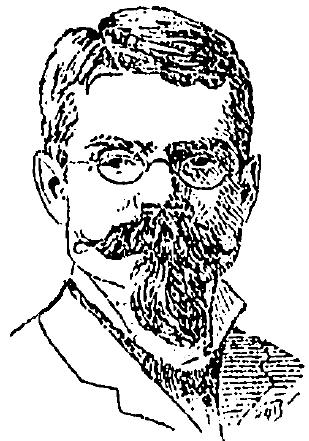
Forrest
Morgan, proofreader for the 1899 uniform edition, helped refine the
works for subsequent editions. |
W. H. W. Bicknell's Contributions
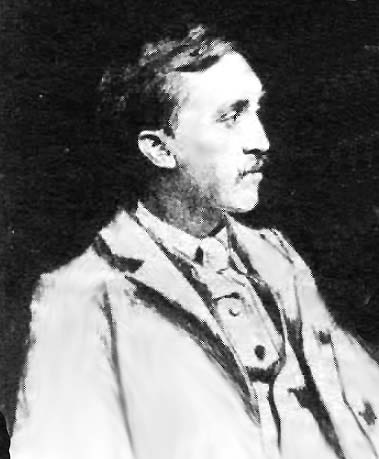
William
Harry Warren Bicknell
photo courtesy of the Winchester, Massachusetts Archival Center |
Frank Bliss hired new illustrators for the 1899 uniform edition.
Artist and etcher William Harry Warren Bicknell (b. 1860 - d. 1947)
was born in Boston, Massachusetts, the son of a grocer. Bicknell graduated
from the Boston Latin School in 1878 and later studied at the Boston
Museum of Fine Arts. He was a pupil of Otto Grundmann and Frederic
Crowningshield. Bicknell etched a number of frontispieces made from
photographs of Clemens that were used throughout the set. Bicknell's
etching of the Tiffany monogram appears as a title page in every volume
of the Autograph Edition,
Edition De Luxe, Japan
Edition, Author's
De Luxe Edition, and the Royal
Edition. All of these editions began issuing in 1899.
Less expensive editions such as Underwood,
Riverdale, and
Hillcrest feature the Tiffany title
page in Volume 1 only. It was elimnated altogether from the Author's
National Edition.
|
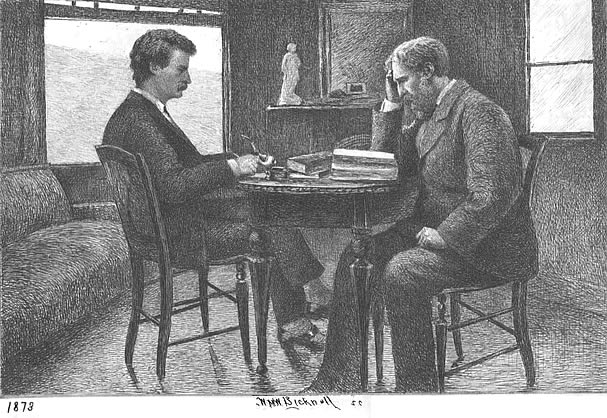
Frontispiece
of Volume 10 etched by William Harry Warren Bicknell was a composite
based on a two separate photographs of Mark Twain and Charles Dudley Warner
in 1873.
William Thomas Smedley, Illustrator
|
Frank Bliss hired William Thomas Smedley (b. 1858 - d. 1920) to illustrate
the 1899 uniform edition of The Gilded Age. When Frank's father
Elisha Bliss was producing the 1873 first edition of The Gilded
Age for American Publishing Company, he considered hiring Smedley,
who worked at Harper's Weekly, for the job. Elisha Bliss provided
Smedley with a copy of the manuscript and paid him $150 for one illustration.
That illustration was never used in the 1873 edition. The reason Smedley
did not get the 1873 assignment from Elisha Bliss is unknown.
Smedley was born in Pennsylvania, the son of a miller. At age fifteen
he began working in a newspaper office in Chester County, Pennsylvania
and later studied art at the Pennsylvania Academy of Fine Arts. He
later was commissioned to travel through the Northwest with Lord
Lorne of Canada. He also visited Hawaii, New Zealand, Australia
and Paris where he studied under Jean-Paul Laurens. In New York he
secured work with Harper's and Scribners.
|
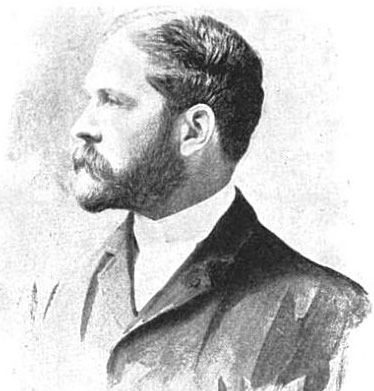
William
Thomas Smedley |
Smedley provided six full-page illustrations for the 1899 uniform editions
of The Gilded Age. Smedley chose to illustrate scenes from the text
that had been previously illustrated with line drawings by illustrators
of the 1873 edition. However, Smedley's artwork for the 1899 edition contained
detailed shadings and less caricature than the illustrations in the first
edition. One receipt from Smedley to American Publishing Company dated December
13, 1898 indicates he was receiving $150 per illustration.
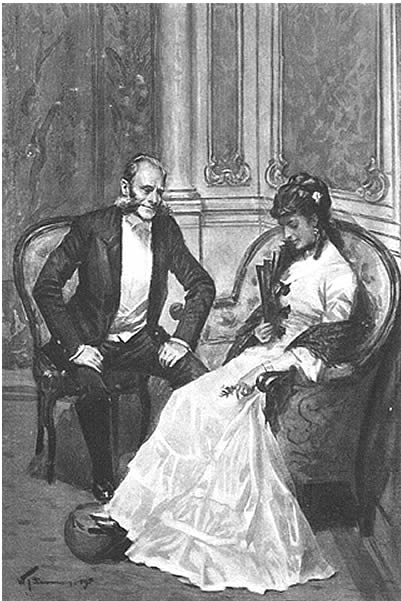
Smedley's
"Laura Coquetting with Mr. Buckstone" was used as the frontispiece
for Volume 11.
The frontispiece for Volume 11 was for the same scene Smedley
had illustrated for the 1873 edition -- an illustration that was never used.
This illustration would have appeared in Chapter 37 of the 1873 edition.
In the 1899 uniform edition, it depicts a passage that appears in Chapter
6 of Volume 11, which is the second volume of The Gilded Age.
